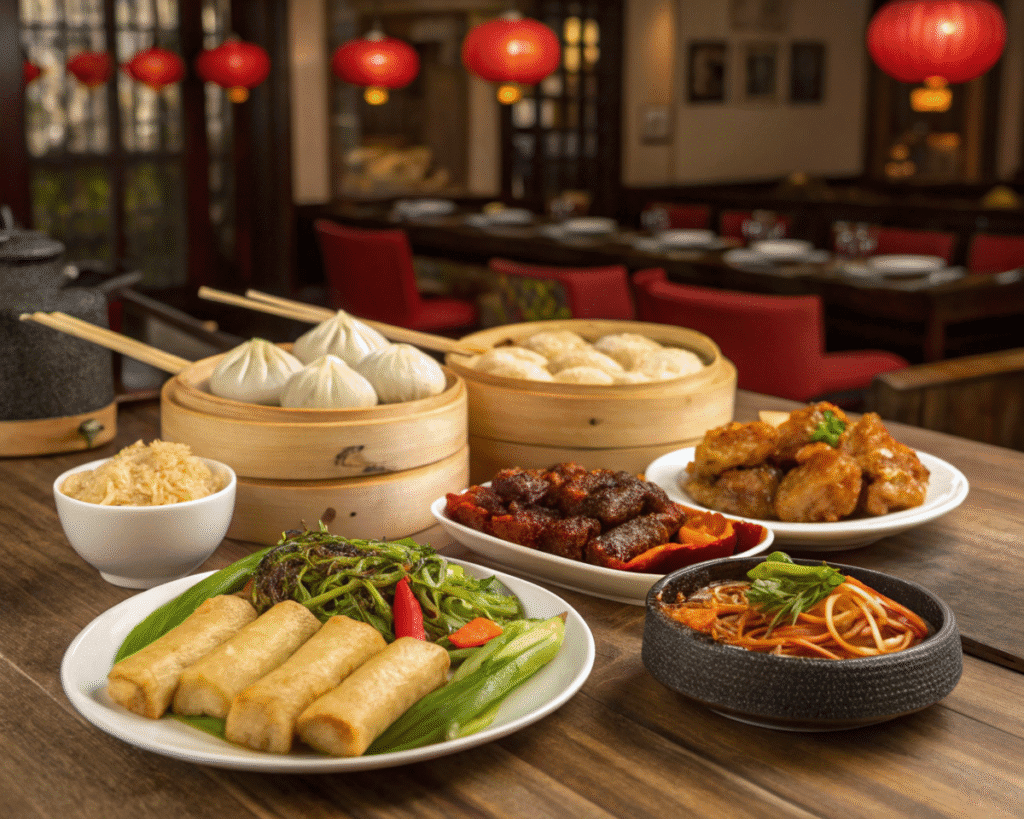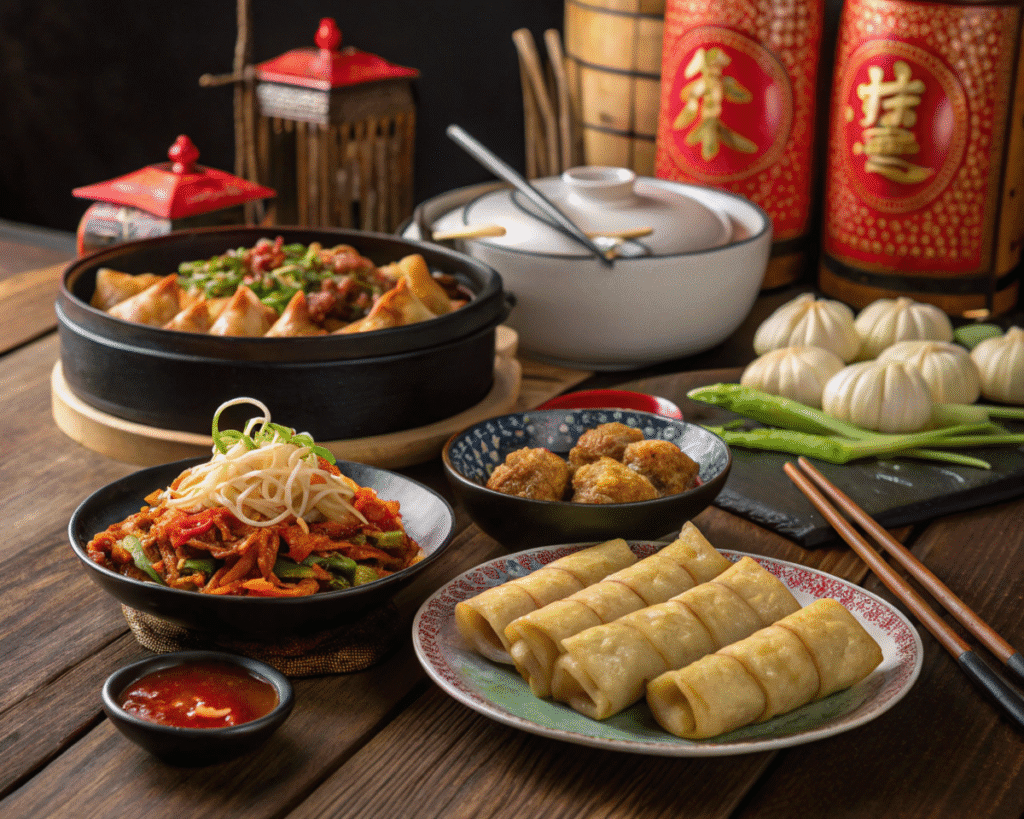Awesome Chinese cuisine captivates food enthusiasts with its bold flavors, diverse textures, and deep cultural roots. From spicy Sichuan dishes to delicate Cantonese dim sum, Chinese cuisine offers a vast array of dishes that reflect the country’s history and regional diversity. we explore how to make awesome Chinese cuisine, its origins, nutritional values, and essential details to deepen your appreciation for this global culinary treasure.
What Is Awesome Chinese Cuisine?
Awesome Chinese cuisine encompasses the rich, varied dishes that define China’s culinary landscape. Known for its balance of flavors—sweet, sour, salty, bitter, and umami—Chinese cuisine uses ingredients like rice, noodles, soy sauce, and fresh vegetables to create unforgettable meals. Signature dishes include Peking duck, mapo tofu, dim sum, and kung pao chicken, each showcasing unique regional techniques and ingredients.
Chinese cuisine emphasizes fresh ingredients, precise cooking methods, and harmony in flavors. Whether it’s the fiery heat of Sichuan peppercorns or the subtle sweetness of Shanghai-style braised pork, awesome Chinese cuisine delivers a sensory experience that appeals to diverse palates worldwide.
Origins of Awesome Chinese Cuisine
Awesome Chinese cuisine traces its roots to China’s ancient culinary traditions, spanning over 5,000 years. Each region—Sichuan, Cantonese, Shandong, Hunan, and more—developed distinct styles based on local ingredients, climate, and culture.
Historical Context
Chinese cuisine began taking shape during the Shang Dynasty (1600–1046 BCE), with early records of rice, millet, and fermented beverages. By the Han Dynasty (206 BCE–220 CE), techniques like stir-frying and steaming emerged, laying the foundation for modern Chinese cooking. The Silk Road introduced spices like Sichuan peppercorns and ingredients like wheat, shaping dishes like noodles and dumplings.
During the Tang (618–907 CE) and Song (960–1279 CE) dynasties, Chinese cuisine flourished as a symbol of prosperity. Imperial courts developed elaborate dishes like Peking duck, while regional cuisines like Cantonese focused on fresh seafood and dim sum. The Ming and Qing dynasties further refined techniques, introducing soy sauce and chili peppers from the Americas, which transformed Sichuan and Hunan cuisines.

Regional Diversity
China’s vast geography birthed eight major culinary styles, each contributing to awesome Chinese cuisine:
- Sichuan: Known for bold, spicy flavors, featuring Sichuan peppercorns and chili oil in dishes like mapo tofu.
- Cantonese: Emphasizes fresh ingredients and delicate flavors, with dim sum and roasted meats like char siu.
- Shandong: Focuses on seafood and hearty dishes, such as braised sea cucumber.
- Hunan: Offers spicy, smoky flavors, as seen in smoked pork with dried vegetables.
- Jiangsu: Features sweet, delicate dishes like braised pork belly (hong shao rou).
- Zhejiang: Known for light, fresh flavors, with dishes like Dongpo pork.
- Fujian: Combines sweet and sour notes, often with seafood, as in lychee pork.
- Anhui: Highlights wild herbs and simple, rustic dishes like stinky tofu.
These regional styles showcase China’s culinary diversity, making awesome Chinese cuisine a global phenomenon.
Cultural Significance
Food in Chinese culture symbolizes unity, prosperity, and harmony. Meals bring families together, especially during festivals like Lunar New Year, where dumplings signify wealth and noodles represent longevity. The philosophy of balance, rooted in yin and yang, influences ingredient pairings and cooking methods, ensuring dishes are both flavorful and nourishing.
Nutritional Values of Awesome Chinese Cuisine
Awesome Chinese cuisine offers a range of nutritional benefits, depending on the dish and preparation method. While some dishes are light and vegetable-focused, others are rich and protein-heavy. Below, we explore the nutritional profiles of key ingredients and popular dishes.
Key Ingredients
- Rice: A staple in Chinese cuisine, providing carbohydrates for energy. A 100-gram serving of cooked white rice contains 130 kcal, 28 g carbs, and 2.7 g protein.
- Noodles: Made from wheat or rice, noodles offer 120–150 kcal per 100 grams, with moderate carbs and protein.
- Vegetables: Bok choy, Chinese broccoli, and bamboo shoots are low-calorie (10–30 kcal per 100 g) and rich in fiber, vitamins A and C, and antioxidants.
- Tofu: A plant-based protein, providing 70 kcal, 8 g protein, and 4 g fat per 100 grams. It’s also high in calcium and iron.
- Pork: Common in dishes like char siu, pork offers 140–200 kcal and 20–25 g protein per 100 grams, though it can be high in fat.
- Soy Sauce: Adds umami but is high in sodium (900 mg per tablespoon), so use sparingly.
Popular Dishes
- Mapo Tofu (Sichuan): A 200-gram serving contains approximately 200 kcal, 15 g protein, 12 g fat, and 10 g carbs. Tofu provides protein, while chili oil adds flavor but increases fat content.
- Kung Pao Chicken: A 200-gram serving offers 250 kcal, 20 g protein, 15 g fat, and 10 g carbs. Peanuts add healthy fats, while chicken provides lean protein.
- Dim Sum (Cantonese): Items like shrimp dumplings (50 kcal each) are low in calories but high in sodium due to soy-based dipping sauces.
- Vegetable Stir-Fry: A 200-gram serving with bok choy and mushrooms contains 80 kcal, 5 g protein, and 3 g fat, making it a nutrient-dense option.
Health Benefits
Awesome Chinese cuisine supports health when prepared with fresh ingredients and balanced flavors. Vegetable-heavy dishes provide fiber and antioxidants, reducing inflammation and aiding digestion. Tofu and lean proteins like chicken offer low-fat protein sources, ideal for muscle health. Fermented foods like soy sauce and pickled vegetables promote gut health but should be consumed in moderation due to sodium content.
However, some dishes, like deep-fried General Tso’s chicken, can be high in calories and fat. Opt for steamed or stir-fried dishes to maximize nutritional benefits while enjoying awesome Chinese cuisine.

How to Make Awesome Chinese Cuisine: Recipes and Techniques
Cooking awesome Chinese cuisine at home is rewarding and accessible. Below, we share two authentic recipes: Sichuan mapo tofu and Cantonese-style shrimp dumplings. Each serves 4 and includes detailed instructions.
Recipe 1: Sichuan Mapo Tofu
This spicy, numbing dish combines silken tofu with ground pork and Sichuan peppercorns for a bold flavor.
Ingredients
- 400 g silken tofu, cut into 2 cm cubes
- 150 g ground pork
- 2 tbsp Sichuan peppercorns, toasted and ground
- 2 tbsp chili oil
- 1 tbsp fermented black beans, rinsed and minced
- 2 cloves garlic, minced
- 1 tbsp ginger, minced
- 2 tbsp doubanjiang (spicy bean paste)
- 1 cup chicken broth
- 1 tbsp soy sauce
- 1 tsp sugar
- 1 tbsp cornstarch mixed with 2 tbsp water
- 2 spring onions, chopped
- 2 tbsp vegetable oil
- Cooked rice, for serving
Instructions
- Prepare Tofu: Gently boil tofu cubes in salted water for 2 minutes to firm them up. Drain and set aside.
- Cook Pork: Heat vegetable oil in a wok over medium heat. Add ground pork and stir-fry until browned, about 3 minutes. Remove and set aside.
- Sauté Aromatics: In the same wok, add chili oil, garlic, ginger, and doubanjiang. Stir-fry for 1 minute until fragrant.
- Combine Ingredients: Add fermented black beans, Sichuan peppercorns, soy sauce, sugar, and chicken broth. Bring to a simmer. Add tofu and pork, gently stirring to coat.
- Thicken Sauce: Stir in cornstarch slurry and cook for 1 minute until the sauce thickens.
- Garnish and Serve: Sprinkle with spring onions and serve hot with rice.
Cooking Time: 25 minutes
Nutritional Info (per serving): 220 kcal, 16 g protein, 14 g fat, 8 g carbs
Recipe 2: Cantonese Shrimp Dumplings (Har Gow)
These translucent dumplings showcase Cantonese precision and delicate flavors.
Ingredients
- Wrapper:
- 1 cup wheat starch
- 1/2 cup tapioca starch
- 1 cup boiling water
- 1 tbsp vegetable oil
- Filling:
- 200 g shrimp, peeled and chopped
- 50 g bamboo shoots, finely chopped
- 1 tbsp sesame oil
- 1 tsp soy sauce
- 1 tsp sugar
- 1 tsp cornstarch
- 1 tbsp minced ginger
- 1 tbsp chopped chives
- Soy sauce and chili oil, for dipping
Instructions
- Make Dough: Mix wheat starch and tapioca starch in a bowl. Pour in boiling water and stir until a dough forms. Add oil and knead until smooth. Cover and rest for 10 minutes.
- Prepare Filling: Combine shrimp, bamboo shoots, sesame oil, soy sauce, sugar, cornstarch, ginger, and chives in a bowl. Mix well.
- Form Dumplings: Roll dough into a log and cut into 12 pieces. Roll each piece into a 3-inch circle. Place 1 tsp filling in the center, fold, and pleat to seal.
- Steam Dumplings: Line a steamer with parchment paper. Steam dumplings over high heat for 8–10 minutes until translucent.
- Serve: Serve hot with soy sauce and chili oil.
Cooking Time: 40 minutes
Nutritional Info (per serving, 3 dumplings): 150 kcal, 8 g protein, 4 g fat, 20 g carbs
Cooking Tips
- Wok Cooking: Use a carbon steel wok for stir-fries to achieve high heat and authentic flavor.
- Fresh Ingredients: Source fresh vegetables and proteins from Asian markets or online retailers like Asian Food Grocer.
- Flavor Balance: Adjust soy sauce, sugar, and vinegar to achieve the perfect balance of salty, sweet, and sour.
Key Ingredients in Awesome Chinese Cuisine
Awesome Chinese cuisine relies on a pantry of versatile ingredients:
- Soy Sauce: Adds umami and depth to stir-fries and marinades.
- Sichuan Peppercorns: Provide a numbing, citrusy heat unique to Sichuan dishes.
- Ginger and Garlic: Form the aromatic base for most dishes.
- Rice Vinegar: Contributes sourness, balancing richer flavors.
- Sesame Oil: Adds nutty aroma to stir-fries and dumplings.
- Star Anise and Five-Spice Powder: Enhance braised dishes with warm, complex flavors.
These ingredients, combined with regional techniques, create the diverse flavors of awesome Chinese cuisine.
Cultural and Culinary Significance
Awesome Chinese cuisine reflects China’s emphasis on community and balance. Meals are often shared family-style, fostering connection. The concept of “fan” (grains like rice) and “cai” (dishes like vegetables or meat) ensures nutritional balance, a practice rooted in Confucian philosophy.
Festivals and Traditions
Chinese cuisine shines during festivals. Lunar New Year features dumplings and whole fish for prosperity, while the Mid-Autumn Festival includes mooncakes. These traditions highlight food’s role in celebrating heritage and unity.
Global Influence
Chinese cuisine spread globally through migration and trade. In the 19th century, Chinese immigrants brought dishes like chow mein to the U.S., adapting them to local tastes. Today, restaurants like Din Tai Fung and P.F. Chang’s introduce awesome Chinese cuisine to international audiences, blending authenticity with innovation.
Pairing Awesome Chinese Cuisine
Elevate your meal with thoughtful pairings:
- Beverages: Pair with jasmine tea or Tsingtao beer to complement flavors. For non-alcoholic options, try lychee juice.
- Sides: Serve with pickled vegetables or scallion pancakes for texture contrast.
- Desserts: Finish with red bean paste buns or mango pudding for a sweet touch.
Where to Find Awesome Chinese Cuisine
In China
Explore local eateries in cities like Chengdu for Sichuan dishes or Guangzhou for Cantonese cuisine. Street markets offer authentic bites like spicy noodles and steamed buns.
Internationally
Restaurants like Din Tai Fung (global locations) and Xi’an Famous Foods (U.S.) serve awesome Chinese cuisine. Online retailers like Asian Food Grocer provide ingredients for home cooking.
Conclusion
Awesome Chinese cuisine celebrates China’s rich culinary heritage, blending bold flavors, regional diversity, and cultural significance. From fiery Sichuan mapo tofu to delicate Cantonese dumplings, these dishes offer something for every palate. Try the recipes, embrace the techniques, and savor the vibrant world of awesome Chinese cuisine in your own kitchen.

